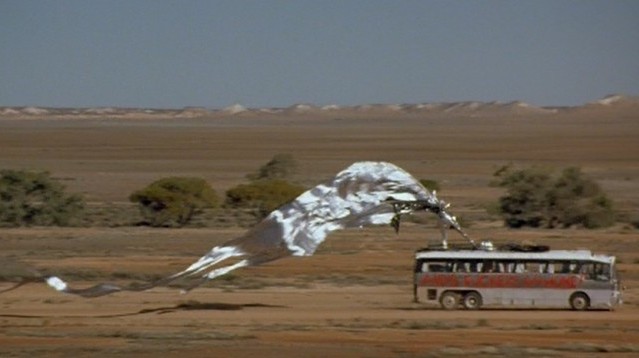Sometimes a film comes out of nowhere is all but perfectly made, hits the zeitgeist perfectly, and never leaves the culture.
In 1994, that film was The Adventures of Priscilla, Queen of the Desert, a road movie about 3 drag queens going through the outback in their rundown bus, Priscilla. They have to travel from Sydney to Alice Springs, which is over 1700 miles. For Americans, this is roughly the equivalent of driving from Seattle to Minneapolis at speeds slower than our own freeway system.
Like all good road movies, the road provides a metaphor for a life’s journey, here with the dual symbols of learning your place in the world and of changing into something bigger than you were. The journeys of each of our protagonists is all a little different. Bernadette is an older MTF transsexual whose new young boyfriend recently died, and is looking to both get over her grief and find a male lover. Mitzi is estranged from his wife and son, whom he is going to meet at the resort in Alice Springs. Felicia is a young and naive rebel who’s out and proud and angry as fuck about it.
Of course, their drag show and queerness is more widely accepted in Sydney than in any of the outback towns that the boys travel through. The most accepting community is the Aboriginal Australian migrant workers, with whom they party all night long without fear of prejudice or violence. The Aboriginals are outcasts to the White Australian society that took over their land, and so are more accepting of outcasts themselves. But, all the white-majority towns they go through along the way have a variety of tolerances, from passive aggressive to disbelief to outright aggression.
Stephan Elliott, the then-supposedly-straight writer and director (who only publicly came out to the public in 2012?!), filled Priscilla with a mixture of humanity and stereotypes. The homosexuals depicted were still emblematic of the cliche, but rounded out to be human beings with feelings and emotions beyond their libidos and inflections. The characters around them are a mixed bag with a relatively racist depiction of a hyper, drunken, deceptive, slutty Filipina who performs the Ping Pong Ball trick as the main offender in the movie.
What Priscilla managed to do successfully was capture the atmosphere of us vs them, urban vs suburban vs rural, inside vs outside, and queer vs straight that was happening in the early 90s. Elliott removed all the political correctness from the gay rights narratives, and made his characters as loud, brash and catty as they exist in real life. The message, of course, is that gay rights isn’t about political correctness, but the search for basic human decency towards each other.
The 90s were the time when gay rights seemed to really take hold. The fear of AIDS had turned into rage. The slow progress of gay rights had finally gained some traction. People were coming out in the media. Gay bashings were starting to be reported. And, the plea for decency started being heard by people who were noticing the number of queers that were everyday folks.
When the queens put on a show in a bar in a one-horse town, they’re received with bewildered eyes, as if somebody just pissed in a beer glass. But, the Filipina stereotype comes in and does her far more outrageous ping pong ball act, and is received with hooting and hollering. What’s so outrageous about guys dressing up as girls when girls are popping balls out of their vagina into an audience? When the guys dress up to drink at a different bar, they’re treated with derision and contempt until Bernadette proves her worth, and even then somebody paints AIDS FUCKERS GO HOME in giant letters on their bus.
All morality and metaphor aside, its the visuals that make Priscilla what it is. It’s rare for a gay movie to look this fantastic, and have meaning behind it. Take the profile image. That shot, when projected on a movie house screen, becomes a moving and epic metaphor for rising above the hate and moving forward regardless of what others think of you. You have to deal and move on as fabulously as possible.
Elliott’s sense of visual metaphor, along with Brian Breheny’s cinematography, works wonders to convey the majesty of the world with the strange world of drag culture. Projected on a big screen, the way it was meant to be (a disco ball should also be involved if at all possible), Priscilla takes on an epic scale filled with the majestic landscapes of the outback as backdrop for the grandiose drag outfits. On a small screen, the metaphors lose most of their punch.
In a way, Priscilla‘s refusal to be a romanticized piece of gay literature is its shining grace. Three drag queens going for gay rights could have easily becomes a by the number polemic which glorified the gays while condemning the heteros. By bringing both sides to levels of human stereotypes that often aren’t openly nasty to each other, Priscilla became a crossover hit that still remains a poignant comedy.

